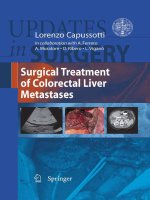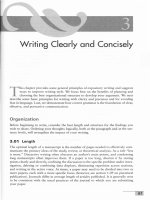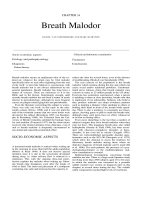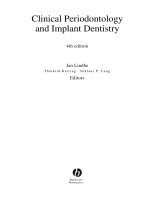SURGICAL MANUAL OF IMPLANT DENTISTRY: STEP-BY-STEP PROCEDURES (2007) pptx
Bạn đang xem bản rút gọn của tài liệu. Xem và tải ngay bản đầy đủ của tài liệu tại đây (14.17 MB, 170 trang )
SURGICAL MANUAL OF IMPLANT DENTISTRY:
STEP-BY-STEP PROCEDURES (2007)
Front Matter
Title Page
Daniel Buser DDS, Dr med dent
Professor and Chairman
Department of Oral Surgery and Stomatology
School of
Dental Medicine
University of Bern
Bern, Switzerland
Jun-Young Cho DDS
Associate Professor
Department of Periodontics
Baylor College of Dentistry
Texas A & M University System Health Science Center
Dallas, Texas
Alvin B.K. Yeo BDS, MSc
Periodontics Unit
Department of Restorative Dentistry
National
Dental Centre
Republic of Singapore
Quintessence Publishing Co, Inc
Chicago, Berlin, Tokyo, London, Paris, Milan, Barcelona, Istanbul, Sao Paulo, Mumbai, Moscow, Prague, and
Warsaw
Copyright Page
Library of Congress Cataloging-in-Publication Data
Buser, Daniel.
Surgical manual of implant dentistry : step-by-step procedures /
Daniel Buser, Jun Y. Cho, Alvin Yeo.
p. ; cm.
ISBN-13: 978-0-86715-379-8
1.
Dental implants Handbooks, manuals, etc. 2. Dental implants
Atlases. I. Cho, Jun Y. II. Yeo, Alvin. III. Title.
[DNLM: 1.
Dental Implantation methods Atlases. 2. Dental
Implantation methods Case Reports. WU 600.7 B977s 2007]
RK667.I45S874 2007
617.6'93 dc22
2006033380
ISBN-13: 978-0-86715-379-8
ISBN-10: 0-86715-379-2
Surgical Manual of Implant Dentistry: Step-By-Step Procedures (2007)
1 of 3 15-01-2009 8:04
© 2007 Quintessence Publishing Co, Inc
Quintessence Publishing Co, Inc
4350 Chandler Drive
Hanover Park, Illinois 60133
www.quintpub.com
All rights reserved. This book or any part thereof may not be reproduced, stored in a retrieval system, or
transmitted in any form or by any means, electronic, mechanical, photocopying, or otherwise, without prior
written permission of the publisher.
Editor: Bryn Goates
Design and production: Dawn Hartman
Printed in Canada
Table of Contents
Preface… vii
1 Basic Surgical Principles… 1
2 Indications for Each Implant Type… 17
3 Surgical Procedures in Standard Nonesthetic Sites… 23
4 Surgical Procedures in Standard Esthetic Sites… 39
5 Surgical Procedures for Implant Placement with Simultaneous Guided Bone Regeneration… 61
6 Surgical Procedures for Implant Placement with Simultaneous Sinus Floor Elevation… 77
7 Clinical Cases… 93
Suggested Reading… 123
Preface
Based on the concept of osseointegration first described by Branemark and Schroeder, implant dentistry has
evolved tremendously over the past 15 years, and today it plays an integral role in
dental rehabilitation.
Though it was developed primarily to rehabilitate fully edentulous patients, since the late 1980s the treatment
focus has gradually shifted to partially edentulous patients. Today, single-tooth replacement is the number one
indication for implant therapy.
Implant dentistry also has benefited from the significant progress made in associated treatment protocols.
Development of bone augmentation procedures allows clinicians to correct alveolar bone deficiencies, while
guided bone regeneration with barrier membranes and sinus floor elevation have become standards of care to
correct bone defects in other parts of the oral cavity. In addition, improved osteophilic microtextured titanium
implant surfaces help to accelerate healing, significantly reducing treatment time. Together, these advances
make implant therapy more predictable and more attractive to patients, and the result has been a rapid
expansion of implant dentistry in daily practice and more clinicians placing
dental implants.
This book is the culmination of many years' effort to standardize surgical technique in implant dentistry. It is
designed for postdoctoral students and practitioners who wish to perform surgical implant procedures in daily
practice with a high predictability for success and a low risk for complications. Basic surgical principles and
procedures for placing
implants both in standard sites and in sites with local defects are presented using
Surgical Manual of Implant Dentistry: Step-By-Step Procedures (2007)
2 of 3 15-01-2009 8:04
detailed explanations and hand-drawn illustrations. The final chapter of the book presents 14 comprehensive
clinical case reports, several documenting long-term follow-ups over a period of 10 years.
The publication of this book coincides with the production of a DVD featuring live surgery of the same surgical
techniques in seven clinical cases. The surgery was recorded during master courses in implant dentistry offered
by the University of Bern.
The authors wish to thank the staff of Quintessence Publishing for their excellent support during the
preparation and production of this book.
© 2007 Quintessence Publishing Co, Inc
Electronic Reference Style Guide
Author:
Daniel Buser DDS, Dr med dent
Jun-Young Cho DDS
Alvin B.K. Yeo BDS, MSc
Copyright:
© 2007 Quintessence Publishing Co, Inc
Database Title:
STAT!Ref Online Electronic Medical Library
ISBN:
0-86715-379-2
978-0-86715-379-8
Publication City:
Hanover Park, Illinois
Publication Year:
2007
Publisher:
Quintessence Publishing Co, Inc.
Title:
Surgical Manual of Implant Dentistry: Step-By-Step Procedures (2007)
Date Posted:
3/20/2008 2:30:03 AM PST (GMT -08:00)
Electronic Address:
/>Date Accessed:
1/15/2009 11:59:18 AM PST (GMT -08:00)
Location In Title:
SURGICAL MANUAL OF IMPLANT DENTISTRY: STEP-BY-STEP PROCEDURES (2007)
Front Matter
Send Feedback
Customer Service
800.901.5494
Title Updates
User Responsibilities
Training Center
What's New
Teton Server (5.9.0) - ©2009 Teton Data Systems
Send Us Your Comments
Surgical Manual of Implant Dentistry: Step-By-Step Procedures (2007)
3 of 3 15-01-2009 8:04
Chapter 1. Basic Surgical Principles
Introduction
This chapter presents the basic surgical principles related to the placement of Straumann implants in partially
edentulous patients. To achieve successful osseointegration, a precise and low-trauma surgical technique is
required. Surgeons must take important measures preoperatively to prevent postsurgical infection, handle
surgical instruments expertly to preserve soft tissues, and carefully accomplish adequate implant site
preparation without overheating the bone. Precise surgical protocol includes the following precautions:
• Preoperative mouthwash with 0.1% chlorhexidine
• Perioral skin disinfection with alcohol solution
• Antibiotic prophylaxis 2 hours prior to surgery (eg, 2 g amoxicillin intraorally)
• Low-speed drilling (between 500 and 600 rpm)
• Cooling spray during drilling with chilled sterile saline
• Intermittent drilling technique
• Use of sharp drills
It is important to perform a surgical procedure systematically, always applying the same surgical principles.
Fig 1-1 Smoothing the alveolar crest following flap elevation.
Fig 1-1a Once the implant surgical site has been exposed, a large round bur is used to smooth and level the
crest of the alveolar ridge.
Surgical Manual of Implant Dentistry: Step-By-Step Procedures (2007)
1 of 17 15-01-2009 8:07
Fig 1-1b All sharp edges and irregularities are removed by running the round bur across the alveolar ridge.
Fig 1-1c In this cross section, the irregular, narrow crest is smoothed to produce a flat, wide ridge, which is
favorable for implant site preparation.
Fig 1-2 Sequence of site preparation for a standard implant.
Fig 1-2a A no. 1 round bur is used to mark the position of the implant site.
Fig 1-2b Access is widened with a no. 2 round bur. This step makes it possible to correctly position the next
drill.
Surgical Manual of Implant Dentistry: Step-By-Step Procedures (2007)
2 of 17 15-01-2009 8:07
Fig 1-2c The initial implant site preparation is made with a 2.2-mm-diameter pilot drill.
Fig 1-2d A 2.2-mm-diameter guide pin is inserted into the initial preparation to check its position and axis.
Fig 1-2e The crest of the osteotomy is enlarged with a no. 3 round bur.
Surgical Manual of Implant Dentistry: Step-By-Step Procedures (2007)
3 of 17 15-01-2009 8:07
Fig 1-2f A 2.8-mm-diameter spiral drill is easily inserted for preparing the depth of the site.
Fig 1-2g A profile drill is used to further increase the surgical access for the next, larger-size drill.
Fig 1-2h Preparation of the implant site continues with the 3.5-mm-diameter spiral drill.
Surgical Manual of Implant Dentistry: Step-By-Step Procedures (2007)
4 of 17 15-01-2009 8:07
Fig 1-2i Occasionally, when the bone structure is uniformly dense, bone tapping is performed prior to implant
placement.
Fig 1-2j A standard implant is placed in the site, with the rough surface positioned at the level of the alveolar
ridge crest. This allows the implant shoulder to be located at the gingival level.
Fig 1-3 Correction of the position and axis of the implant site
preparation.
Fig 1-3a The preparation of the implant site begins with the use of the nos. 1 and 2 round burs to mark the
Surgical Manual of Implant Dentistry: Step-By-Step Procedures (2007)
5 of 17 15-01-2009 8:07
position of the implant site.
Figs 1-3b and 1-3c Any required changes to the marking made with the first round bur can be accomplished
with the no. 2 round bur, as shown in this occlusal view. These initial steps for the preparation of the implant
site ensure the correct implant position orofacially and mesiodistally.
Fig 1-3d After the use of the first pilot drill (A), a 2.2-mm-diameter guide pin is used to check the axis and
depth of the implant preparation (B). Any incorrect axis orientation can be adjusted with the same 2.2-mm-
diameter pilot drill (C and D) and then followed with the 2.8-mm-diameter spiral drill (E).
Fig 1-4 Pretapping of implant sites with bone of varying
density.
Surgical Manual of Implant Dentistry: Step-By-Step Procedures (2007)
6 of 17 15-01-2009 8:07
Fig 1-4a Tapping of the bone in the implant site is performed when the bone structure is uniformly dense (ie,
type 1 bone). This is done through the entire depth of the implant bed.
Fig 1-4b If the alveolar ridge is partially dense (ie, type 2), tapping of the implant site to one third of the
predetermined depth is done within the crestal area.
Fig 1-4c When the alveolar ridge is predominantly cancellous bone (ie, types 3 and 4), no tapping of the bone
is required prior to implant placement.
Fig 1-5 Varying sink depths.
Surgical Manual of Implant Dentistry: Step-By-Step Procedures (2007)
7 of 17 15-01-2009 8:07
Fig 1-5a The 3.5-mm-diameter depth gauge is inserted so that the middle of the 12-mm mark is aligned with
the bone crest (left). When the standard implant is inserted, this allows the rough border to be aligned exactly
at the crest (right).
Fig 1-5b If the implant site is prepared with the 12-mm mark slightly below the crest, the rough border of the
inserted implant will be positioned approximately 0.5 mm below the crest. This approach is most often used in
posterior implant sites for a nonsubmerged implant healing.
Surgical Manual of Implant Dentistry: Step-By-Step Procedures (2007)
8 of 17 15-01-2009 8:07
Fig 1-5c The implant site is prepared to the 14-mm mark, and the profile drill is used to flare the coronal
portion of the crest. A 12-mm-long standard implant can be inserted more deeply to partially submerge the
machined collar. This approach is normally used in esthetic implant sites for a submerged implant healing.
Fig 1-6 Overview of implant site preparation and implant
placement.
Fig 1-6a The implant site is prepared to a diameter of 2.8 mm to receive a narrow neck or a reduced-diameter
implant. Pretapping, as shown in
Fig 1-4, is rarely used with these implants.
Surgical Manual of Implant Dentistry: Step-By-Step Procedures (2007)
9 of 17 15-01-2009 8:07
Fig 1-6b When a standard implant is used, the implant site is prepared to a diameter of 3.5 mm. Pretapping,
as shown in
Fig 1-4, is rarely used.
Fig 1-6c The implant site is prepared to a diameter of 4.2 mm, and a wide body or wide neck implant is
inserted. Pretapping, as shown in
Fig 1-4, is used more often due to larger implant diameter.
Fig 1-7 Selection of implant length in the posterior mandible.
Surgical Manual of Implant Dentistry: Step-By-Step Procedures (2007)
10 of 17 15-01-2009 8:07
Fig 1-7a In regions restricted by anatomic limitations, shorter implants are frequently used. In this long-span
mandibular distal extension situation, two implants are placed to support a three-unit fixed partial denture. An
8-mm short implant (right) is used to avoid the mandibular canal.
Fig 1-7b In a short-span mandibular distal extension situation, two short implants with lengths of 6 and/or 8
mm may be indicated. They are used here to avoid the mandibular canal. These short implants are often
restored with splinted crowns.
Fig 1-8 Selection of implant length in the posterior maxilla.
Fig 1-8 In the maxillary posterior distal extension situation, the maxillary sinus can be avoided with the use of
shorter implants. Here, two implants (12 and 8 mm) are inserted in the second premolar and first molar sites,
respectively, in close proximity to the sinus.
Fig 1-9 Minimum width of alveolar crest for implants of varying
diameter.
Surgical Manual of Implant Dentistry: Step-By-Step Procedures (2007)
11 of 17 15-01-2009 8:07
Fig 1-9a In the premolar site, a crest width of at least 6 mm is recommended for a standard implant.
Fig 1-9b In the molar site, a wide body or wide neck implant requires a minimum crest width of 7 mm.
Fig 1-9c In the anterior region, where a narrow neck implant is often indicated for the replacement of lateral
incisors, a minimum alveolar crest width of 5 mm is required.
Fig 1-10 Minimum space of single-tooth gaps for various
implant types.
Figs 1-10a and 1-10b Occlusal (a) and lateral (b) views of regular neck implants. A space of at least 7 mm is
required for the 4.8-mm-diameter implant shoulder shown here.
Surgical Manual of Implant Dentistry: Step-By-Step Procedures (2007)
12 of 17 15-01-2009 8:07
Figs 1-10c and 1-10d Occlusal (c) and lateral (d) views of wide neck implants. The 6.5-mm-diameter
implant shoulder requires a single-tooth gap of at least 9 mm.
Figs 1-10e and 1-10f Occlusal (e) and lateral (f) views of narrow neck implants. In sites that require narrow
neck implants, a minimum of 5.5 mm is needed to accommodate the 3.5-mm-diameter implant shoulder.
Surgical Manual of Implant Dentistry: Step-By-Step Procedures (2007)
13 of 17 15-01-2009 8:07
Fig 1-10g A minimum interocclusal distance of 5.5 mm from the implant shoulder to the opposing dentition is
necessary to allow the placement of the abutment and crown.
Fig 1-11 Spacing between implants or between implants and
teeth.
Figs 1-11a and 1-11b Occlusal (a) and lateral (b) views of a regular neck implant placed next to a tooth. A
distance of approximately 4 to 5 mm is required between the central axis of the implant and the root surface of
the tooth at the alveolar crest.
Surgical Manual of Implant Dentistry: Step-By-Step Procedures (2007)
14 of 17 15-01-2009 8:07
Figs 1-11c and 1-11d Occlusal (c) and lateral (d) views of a wide neck implant placed next to a second
premolar. The wide neck implant is positioned approximately 5 to 6 mm from the tooth.
Figs 1-11e and 1-11f Occlusal (e) and lateral (f) views of regular neck implants. When two regular neck
implants are placed side by side in a posterior distal extension situation, the first implant should be positioned
4 to 5 mm from the tooth and the second implant should be positioned 7 to 8 mm from the anterior implant.
Figs 1-11g and 1-11h Occlusal (g) and lateral (h) views of regular neck and wide neck implants. When a
regular neck implant and a wide neck implant are indicated to replace a missing second premolar and molar,
the regular neck implant should be placed 4 to 5 mm from the tooth and the wide neck implant placed
approximately 9 mm from the anterior implant.
Surgical Manual of Implant Dentistry: Step-By-Step Procedures (2007)
15 of 17 15-01-2009 8:07
Figs 1-11i and 1-11j Occlusal (i) and lateral (j) views of implants positioned in the first premolar and first
molar sites. In this extended posterior distal extension situation, a regular neck implant and a wide neck
implant are indicated as abutments for a three-unit fixed partial denture. The regular neck implant is positioned
4 to 5 mm from the tooth. The wide neck implant is inserted about 16 mm from the anterior implant.
Figs 1-11k and 1-11l Occlusal (k) and lateral (l) views of a short distal extension situation. A regular neck
implant is indicated to restore the missing first molar and serve as a distal abutment to a combined tooth- and
implant-supported three-unit fixed partial denture. The implant is positioned 11 to 12 mm from the tooth.
© 2007 Quintessence Publishing Co, Inc
Electronic Reference Style Guide
Author:
Daniel Buser DDS, Dr med dent
Jun-Young Cho DDS
Alvin B.K. Yeo BDS, MSc
Copyright:
© 2007 Quintessence Publishing Co, Inc
Database Title:
STAT!Ref Online Electronic Medical Library
ISBN:
0-86715-379-2
978-0-86715-379-8
Surgical Manual of Implant Dentistry: Step-By-Step Procedures (2007)
16 of 17 15-01-2009 8:07
Publication City:
Hanover Park, Illinois
Publication Year:
2007
Publisher:
Quintessence Publishing Co, Inc.
Title:
Surgical Manual of Implant Dentistry: Step-By-Step Procedures (2007)
Date Posted:
3/20/2008 2:30:03 AM PST (GMT -08:00)
Electronic Address:
/>Date Accessed:
1/15/2009 12:07:35 PM PST (GMT -08:00)
Location In Title:
SURGICAL MANUAL OF IMPLANT DENTISTRY: STEP-BY-STEP PROCEDURES (2007)
Chapter 1. Basic Surgical Principles
Send Feedback
Customer Service
800.901.5494
Title Updates
User Responsibilities
Training Center
What's New
Teton Server (5.9.0) - ©2009 Teton Data Systems
Send Us Your Comments
Surgical Manual of Implant Dentistry: Step-By-Step Procedures (2007)
17 of 17 15-01-2009 8:07
Chapter 2. Indications for Each Implant Type
Introduction
Modern implant systems, such as the Straumann Dental Implant System, offer a variety of different implant
types for the various clinical indications of implant therapy. More than 25 years ago, most implant systems
offered just one implant type, primarily to treat fully edentulous patients with implant-borne restorations; the
standard implant dates back to 1986. Due to the expansion of implant therapy for partially edentulous patients
in the late 1980s, the application of
implants has steadily increased. In recent years, the single-tooth gap and
the distal extension situation have become the two most important indications for implant therapy.
Today, screw-type
implants are generally preferred in implant dentistry. Therefore, the diameter of the main
implant body with its thread must be differentiated from the diameter of the implant shoulder (other implant
systems call it a platform). The Straumann
Dental Implant System includes three diameters for implant
shoulders (ie, regular neck, wide neck, and narrow neck) and three diameters for implant threads (ie, standard,
wide body, reduced diameter, and tapered effect).
This chapter presents the author's preferences where these implant types are primarily used.
Fig 2-1 Standard implant.
Fig 2-1a Two standard implants are restored with a three-unit fixed partial denture in a mandibular distal
extension situation. The
implants provide adequate support and function against the opposing dentition.
Surgical Manual of Implant Dentistry: Step-By-Step Procedures (2007)
1 of 6 15-01-2009 8:09
Fig 2-1b For this single-tooth gap, a 12-mm-long standard implant is indicated to replace a missing
mandibular second premolar.
Fig 2-2 Standard plus implant.
Fig 2-2a In an esthetic restoration involving a single-tooth gap in the anterior region, a standard plus implant
is indicated to replace a missing central incisor.
Fig 2-2b A standard plus implant can also be used to replace a maxillary canine in the esthetic zone.
Fig 2-3 Wide body implant.
Surgical Manual of Implant Dentistry: Step-By-Step Procedures (2007)
2 of 6 15-01-2009 8:09
Fig 2-3a Shorter and wider implants are indicated in the posterior maxilla to avoid the maxillary sinus. A
standard implant is indicated in the second premolar site, and a wide body implant is indicated in the first
molar site.
Fig 2-3b Shorter and wider implants are also indicated in the posterior mandible to avoid the mandibular
canal. Two wide body
implants can be placed in the first and second molar sites. These implants are restored
and, in cases of short 6-mm
implants, routinely splinted.
Fig 2-4 Wide neck implant.
Fig 2-4a A wide neck implant is ideal for a single-tooth gap in the first molar position.
Surgical Manual of Implant Dentistry: Step-By-Step Procedures (2007)
3 of 6 15-01-2009 8:09
Fig 2-4b In a posterior distal extension situation, a standard implant and a wide neck implant are ideal
replacements for a missing second premolar and first molar, respectively.
Fig 2-5 Narrow neck implant.
Fig 2-5a A narrow neck implant is indicated to replace a missing lateral incisor where the single-tooth gap
offers limited space.
Fig 2-5b Another indication for a narrow neck implant is to replace missing mandibular incisors where
available tooth space is likewise restricted.
Fig 2-6 Reduced-diameter implant.
Surgical Manual of Implant Dentistry: Step-By-Step Procedures (2007)
4 of 6 15-01-2009 8:09
Fig 2-6 For situations in which the posterior distal extension has inadequate alveolar ridge width, reduced-
diameter
implants can be used in premolar sites, whereas a standard implant can be placed in the first molar
position. Splinting of the crowns is recommended when
implants of reduced diameter are used.
Fig 2-7 Tapered effect implant.
Fig 2-7a For a single-tooth gap following an extraction in the anterior maxilla, a tapered effect implant is
indicated to replace a missing central incisor.
Fig 2-7b In the extraction socket of a first premolar, a tapered effect implant can also be indicated for early
implant placement.
© 2007 Quintessence Publishing Co, Inc
Electronic Reference Style Guide
Author:
Daniel Buser DDS, Dr med dent
Surgical Manual of Implant Dentistry: Step-By-Step Procedures (2007)
5 of 6 15-01-2009 8:09









